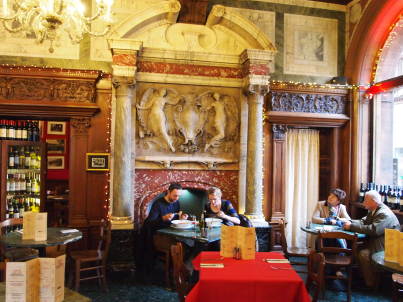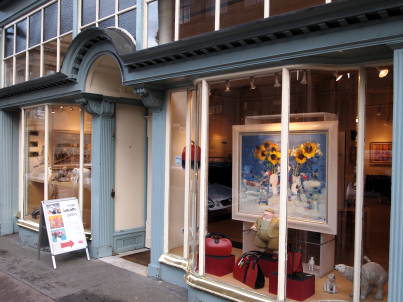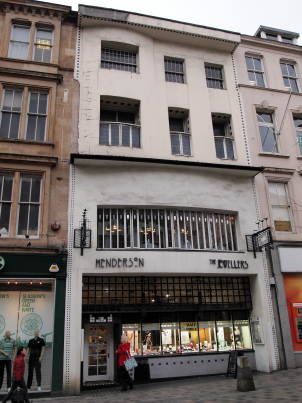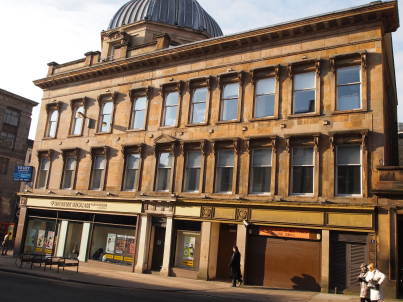The Measured Mile Of Art / Open Doors To Art ....?
by Ian Mitchell, November 2012
 Glasgow had been an art centre in the early nineteenth century, with painters, notably John Knox and later his pupil Horatio MacCulloch based in the city. However Edinburgh with its Royal Scottish Academy and National Galleries of Scotland dominated the art scene in Scotland till the later decades of the nineteenth century when the centre of gravity of Scottish artistic creativity shifted towards Glasgow, where, with brief intermissions, it has arguably remained since. A good example of this is the Edinburgh-born artist J.D.Fergusson, after many years in France, returning in 1939 to spend his last decades in Glasgow, which he regarded as the more creative of the two cities.
Glasgow had been an art centre in the early nineteenth century, with painters, notably John Knox and later his pupil Horatio MacCulloch based in the city. However Edinburgh with its Royal Scottish Academy and National Galleries of Scotland dominated the art scene in Scotland till the later decades of the nineteenth century when the centre of gravity of Scottish artistic creativity shifted towards Glasgow, where, with brief intermissions, it has arguably remained since. A good example of this is the Edinburgh-born artist J.D.Fergusson, after many years in France, returning in 1939 to spend his last decades in Glasgow, which he regarded as the more creative of the two cities.
And then ? as now ? the centre of this artistic world was around Blythswood Hill, an area of former grand bourgeois town houses dating from the early nineteenth century, which by its latter decades had been abandoned by their inhabitants for fresher fields further west, and which thereafter provided excellent accommodation for not only offices, but also for clubs, galleries and artists studios. Let us go on walkabout in this quartier and enjoy the gallery and cafe life which it displays today, as it has done for a century and a half. It is an easy mile of an amble all told.
Alexander Reid had led an exciting life in bohemian Paris in the 1880s, including sharing a flat with Van Goch (who painted his portrait) and almost sharing a suicide pact with the artists as well. When he returned to Glasgow and set up as an art dealer with his Societe des Beaux Arts gallery in 1889 life was to be less exciting, but more lucrative as he became Scotland's leading art dealer, and one of the foremost in Britain.( Much of the now world famous Burrell Collection was amassed for Burrell by Reid.). Reid's fascinating story is told in exemplary fashion by Frances Fowle in Van Goch's Twin (2010). At the bottom of Blythswood hill at 117 West George Street was the gallery Reid ran around 1904 when he was well established, and it is a convenient starting point for our tour. The gallery was housed in the recently constructed Sun Life building designed by the architect William Leiper (who had constructed the famous Templeton's carpet factory on Glasgow Green ) built ? appropriately given the title of Reid's firm ? in the Beaux Arts style. The former insurance office in the building, now Sarti's restaurant, forms a sumptuous marble sculpture palace in which to partake of a fortifying coffee before proceeding.
 This was not Reid's first gallery, to see where that lay we have to walk steeply up West George Street, climbing Blythswood hill, and passing Ewan Mundy Fine Art, to No. 227 (on the corner with West Campbell Street) built in the dominant neo-classical style of the bourgeois townhouses, which mushroomed here along grid-plan lines in the 1820s and 30. It was at No 227 that Reid began, from 1889, to introduce the Glasgow public to new developments in French art, to Impressionism and Post-Impressionism, long before they became fashionable in Edinburgh ? or even in London. It was also here that he promoted the emerging artistic school later known as the Glasgow Boys, painters such as James Guthrie, John Lavery and Joseph Crawhall, influenced by the new trends in French art, and who collectively were the most important painters in Britain in the 1880s and 90s. Roger Billcliffe's monumental work, The Glasgow Boys (2008) is a fine account of the group. Possibly less sure of their own taste, and relying on that of Reid, the new wealth of the Glasgow industrial and commercial bourgeosie was more willing to buy these artists than the old wealth represented by Edinburgh.
This was not Reid's first gallery, to see where that lay we have to walk steeply up West George Street, climbing Blythswood hill, and passing Ewan Mundy Fine Art, to No. 227 (on the corner with West Campbell Street) built in the dominant neo-classical style of the bourgeois townhouses, which mushroomed here along grid-plan lines in the 1820s and 30. It was at No 227 that Reid began, from 1889, to introduce the Glasgow public to new developments in French art, to Impressionism and Post-Impressionism, long before they became fashionable in Edinburgh ? or even in London. It was also here that he promoted the emerging artistic school later known as the Glasgow Boys, painters such as James Guthrie, John Lavery and Joseph Crawhall, influenced by the new trends in French art, and who collectively were the most important painters in Britain in the 1880s and 90s. Roger Billcliffe's monumental work, The Glasgow Boys (2008) is a fine account of the group. Possibly less sure of their own taste, and relying on that of Reid, the new wealth of the Glasgow industrial and commercial bourgeosie was more willing to buy these artists than the old wealth represented by Edinburgh.
West George Street leads us up to the crown of Blythswood hill and to Blythswood Square, splendid town houses set around a private garden. Around 1850 this was possibly the most prestigious address in Glasgow. The days when a Glasgow dealer was the main conduit of European Art into Britain as was Reid, will probably never return, but Glasgow still has several galleries on Blythswood hill where enterprising dealers continue to host exhibitions and showcase the best of contemporary Scottish and British art. One of these is just off Blythswood Square, a little downhill in West Regent Street, where we find the current establishment of a stalwart of the Glasgow art scene for over 60 years, Cyril Gerber's Compass Gallery. (A little downhill and around the corner in Blythswood Street is another that merits mention, the Roger Billcliffe Gallery, which we shall pass later.) Both of these galleries were very forward in the promotion of the New Glasgow Boys school of the 1980s which, a century after their namesakes, (and after a fairly arid period for painting in the city in the 1960s and 70s) had such a profound effect on art in the UK, and on re-establishing Glasgow as a City of Culture. Unlike the Glasgow Boys of the 1880s, who painted mainly rural scenes which appealed to the escapist desires of their rich urban patrons, the New Boys- such as Howson, Currie, Wiszniewski and Campbell, were heavily influenced by urban imagery, especially that reflecting Glasgow's industrial past and current decline. (A fine quartet of paintings, one by each of these artists, hands in the foyer of the Glasgow Concert Hall at the foot of Sauchiehall Street, and is worth a visit after taking this tour)
But back to Blythswood Square. At No 5 is a house whose Art Nouveau exterior is at odds with the classical symmetry of the rest of the square. This is the Glasgow Society of Lady Artists formed in 1882 and which was to be a gathering place for the famous Glasgow Girls group of artists, including Margaret and Frances MacDonald and Bessie MacNicol. They were the female counterpart to the movement initiated by Charles Rennie Mackintosh in the 1890s which introduced the world to the Glasgow Style, an original Scottish take on Art Nouveau. Mackintosh actually designed the remodelled stonework and doorway of No 5 (and some of the interior) for the Society of Lady Artists in 1908 -planning permission would never be granted for this today! An even more famous house stands next door at No 6, Madelene Smith House, named after the female occupant accused in the famous mid Victorian murder trial of killing her lover with poisoned chocolate.
 The longest survivor on the Glasgow art scene, which recently celebrated its 150th birthday is the Royal Glasgow Institute of the Fine Arts which now lies just around the corner from Blythswood Square, down Douglas Street. Founded in 1861, the RGI offered a forum for new, contemporary painting and younger Scottish artist, as well as later exhibiting British and Continental painters. Their annual exhibitions before the First World War were regarded as second in importance in the UK only to those of the Royal Academy in London itself. Success possibly made the RGI become part of the art Establishment and between the wars of the twentieth century it ceased to be at the vanguard of new developments in painting, a situation that has been reversed in recent years.
The longest survivor on the Glasgow art scene, which recently celebrated its 150th birthday is the Royal Glasgow Institute of the Fine Arts which now lies just around the corner from Blythswood Square, down Douglas Street. Founded in 1861, the RGI offered a forum for new, contemporary painting and younger Scottish artist, as well as later exhibiting British and Continental painters. Their annual exhibitions before the First World War were regarded as second in importance in the UK only to those of the Royal Academy in London itself. Success possibly made the RGI become part of the art Establishment and between the wars of the twentieth century it ceased to be at the vanguard of new developments in painting, a situation that has been reversed in recent years.
Clubs were an important part of the arts scene and in Glasgow none more so that the Art Club, reached by carrying on down Douglas Street to Bath Street, and taking a right turn past the Scotlandart Gallery. Originally founded in 1867, the club acquired this pair of A-Listed 1830s town houses and the buildings were remodelled internally in the 1890s by the architects for whom Rennie Mackintosh worked and he himself had a strong influence on the restructuring. The Art Club held not only exhibitions, but was a social gathering place holding dinners and balls. This it still today with its bar and restaurant, and the hosting of concerts and other events in an attempt to come out of a period of semi-hibernation and reach out to a wider public. Though less stuffy and conservative possibly than its Edinburgh counterparts, the Art Club could still be a little behind the times; several of the Glasgow Boys were initially refused membership when they first applied - though later they were all to become members and have their work displayed at Art Club exhibitions.
As well as the clubs and galleries existing on Blythswood hill, many of the artists active in the city from the 1870s till about 1940, actually had their studios and living quarters here. Both Guthrie and Lavery had Bath Street addresses in the 1880s, David Gauld, another Glasgow Boy was to be found in Blythswood Square in the 1900s, and Leslie Hunter the eminent Colourist painter, was based in West George Street in the 1920s. The last main artist to have worked here appears to be the sculptor Benno Schotz who was still operating in West Campbell Street in the 1930s.
A left turn a little beyond the Art Club on Bath Street down Blythswood Street takes us past the very attractive frontage of the Roger Billcliffe Gallery, mentioned earlier, to Sauchiehall Street which forms the boundary between Blythswood hill to its south and Garnethill to its north - and here we are still in artistic territory. Artists needed places to eat and drink and, just around the corner from the Roger Billcliffe gallery lies the Willow Tearooms designed by Mackintosh for Miss Cranston in 1903-4 and patronised by the artistic set of the Edwardian era. Even if not thirsty, take a trip inside and wonder at the amazing interior, which matches the exterior, whilst enjoying your tea and scones.
 Passing westwards here, we see on the right the McLellan Galleries, a building indicative of the wealth produced by Victorian Glasgow in that it was built as the private gallery (with permitted public access) of coach builder and property developer Archibald McLellan to house his collection of paintings. When he died in 1854 they became, with the building, the property of Glasgow Corporation and formed the nucleus of the city's art collection. The fact that almost all of McLellan's paintings consisted on Dutch and Italian Old Masters shows the taste of mid nineteenth century Glasgow, a taste that Alexander Reid did so much to educate and change. Incidentally the Corporation paid £30,000 for the building and £15,000 for McLellan's paintings, which are now worth many thousand times that figure. The Galleries under corporation ownership proved another location for exhibitions and art shows by such as the RGI and Reid's Beaux Arts Society, till 1901 when its collection was moved to Kelvingrove Museum.
Passing westwards here, we see on the right the McLellan Galleries, a building indicative of the wealth produced by Victorian Glasgow in that it was built as the private gallery (with permitted public access) of coach builder and property developer Archibald McLellan to house his collection of paintings. When he died in 1854 they became, with the building, the property of Glasgow Corporation and formed the nucleus of the city's art collection. The fact that almost all of McLellan's paintings consisted on Dutch and Italian Old Masters shows the taste of mid nineteenth century Glasgow, a taste that Alexander Reid did so much to educate and change. Incidentally the Corporation paid £30,000 for the building and £15,000 for McLellan's paintings, which are now worth many thousand times that figure. The Galleries under corporation ownership proved another location for exhibitions and art shows by such as the RGI and Reid's Beaux Arts Society, till 1901 when its collection was moved to Kelvingrove Museum.
An amble of a few hundred yards further westwards brings us to what might be seen as the twentieth century equivalent of the McLellan Galleries, the now named Centre for Contemporary Arts, but still known by many Glasgwegians as the Third Eye Centre under which name it originally opened. As well as refocusing in its exhibitions on many of the artists who were active in Glasgow in the 1940s and 50s such as Bett Low and Joseph Herman, the Third Eye was an important place for the exhibition of the work of the New Glasgow Boys of the 1980s and 90s. The gallery is itself situated in a masterpiece, Alexander "Greek" Thomson's Grecian Halls, built in 1865, though sadly little remains of the interior to match the grand exterior. .
But, if you don't mind a steep pech uphill once again, few would dispute that an even greater masterpiece overlooks this whole artistic quarter of Glasgow, one of Glasgow, Britain and even the world's greatest architectural treasures, Charles Rennie Mackintosh's Glasgow School of Art, reached by climbing Douglas Street. It was possibly not the institution it was to become until taken over by Fra Newberry in 1885, who began to transform everything from the teaching to the building itself, the present one being constructed to designs by Mackintosh from 1899 to 1909. Arguably the peer of any art school in the UK, the Glasgow School of Art has continued to pour forth a whole stream of talented artists, on occasion coalescing into an outpouring of genius as in the 1980s.
Recently there was much raising of London eyebrows (and doubtless of a few in Edinburgh) at the third consecutive award of the prestigious Turner Prize to a former student of Glasgow School of Art. This is, however, better seen not as the "Glasgow Miracle" some talked about but as an expression of the fact that for most of the last 150 years Glasgow has been at the forefront of Scottish artistic innovation, and frequently of that of the whole of Britain as well.
For a city to flourish at any period as an artistic centre several factors are needed to be operating at once. There has to be an institution which functions as an ideas powerhouse, there has to be a cluster of places where artists can meet, of cafes, clubs, studios and of galleries willing to exhibit their works, and last but not least, the existence of an audience which provides patronage in the form of an art-buying public. (The artist starving in his garret in not usually a productive one.) These factors combine to produce what one critic has called an artistic ecology Glasgow had all these a century of more ago, in a different form, has them all today, something I have tried to convey in this all too brief overview.
Ian Mitchell - November, 2012







